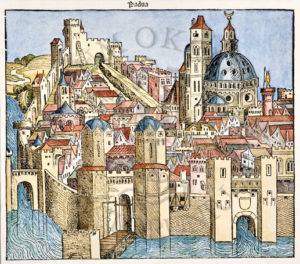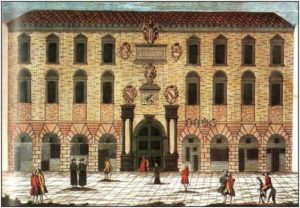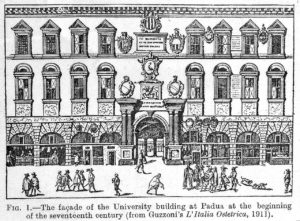Jan Zamoyski was born in the middle of the 16th century. He came from an aristocratic Polish family. As a young boy he lived in the court of the French dauphin (he was sent there by his father). He didn’t enjoy his life during the time spent in France, so he decided to go to the university of Padua. When he had finished his studies, he was working in the courts of 3 Polish kings. At the end of his life he built an ideal city – Zamość. In 1992 the Old Town of this town was placed on the UNESCO heritage list.
 The period in which Jan Zamoyski studied in Padua would have an impact on his whole life. He used the skills and knowledge he gained there during his service at the court of Polish kings – Sigismund Augustus and Stefan Batory. Renaissance ideas would also become an inspiration for Zamoyski to build an ideal city. Although before going to study in Italy, he was at the French court, sent there by his father to acquire the skills necessary for court service, he quickly learned that this was not his place. Therefore, a few months later, he went to Padua to study at one of the most famous and oldest universities in Europe. It was his chance to start a great career. Zamoyski was only 19 years old at the time of his studies, but despite such a young age, he already had a vision of his future.
The period in which Jan Zamoyski studied in Padua would have an impact on his whole life. He used the skills and knowledge he gained there during his service at the court of Polish kings – Sigismund Augustus and Stefan Batory. Renaissance ideas would also become an inspiration for Zamoyski to build an ideal city. Although before going to study in Italy, he was at the French court, sent there by his father to acquire the skills necessary for court service, he quickly learned that this was not his place. Therefore, a few months later, he went to Padua to study at one of the most famous and oldest universities in Europe. It was his chance to start a great career. Zamoyski was only 19 years old at the time of his studies, but despite such a young age, he already had a vision of his future.
At this time, the University of Padua was one of the most esteemed universities. Many well-known Poles also studied before Zamoyski: Klemens Janicki, Łukasz Górnicki, Jan Kochanowski and Mikołaj Kopernik. The best professors of this era lectured at Padua University – Francesco Robortello, Aristotle’s expert and researcher, commentator on his Poetics, an outstanding teacher of philosophy and rhetoric. Carlo Sigonio – an expert on Roman law, commentator of Cicero, participant of the famous literary and scientific dispute with Robortello. Padua was an unusual place, steeped in the atmosphere of curiosity and passion for antiquity. Here many guiding thoughts of the Renaissance were born, here the list of Cicero, discovered for posterity, was studied with enthusiasm, and passion for his works was discussed. Write like Cicero, talk like Cicero and even suffer like him, these were the subjects of many university discussions and disputes.
 Young Zamoyski wanted to make as much use as possible of what the university offered him. Therefore, even though he joined the faculty of law and liberal arts – this course combined philology, theology, nature, philosophy and medicine – he willingly attended other teachers’ lectures. During his stay, he studied under the supervision of the greatest professors of his century. He attended lectures by Carl Sigonius, who became one of his closest friends and mentor in Padua. The professor supported him with his knowledge and experience. He also helped his student to edit the work “De senatu Romano libri II”. Zamoyski described the senator’s office, its functions, structure, tasks and duties. The topic he chose was not accidental. On the one hand, it may seem that the young man was simply inspired by the work of Sygonius “De antiquo iure civium Romanorum libri II”. However, there may be another reason behind the creation of his work. Zamoyski knew that while writing his books he could gain knowledge that would be useful in the future for the development of his political career in Poland. Another goal he wanted to achieve by writing this book was to create a handbook for those who will rule Poland in the future. The guidelines included in the work were addressed to everyone who wanted to work for the Commonwealth and to create a strong and efficient state from it. In the first part of his work, Zamoyski considers in detail the tasks and duties of the senator, in the second part raises the issue of the senate – about its activities, importance and seriousness. Zamoyski, while working on his work, drew abundantly from ancient sources and also referred to the work and legal experience of his master Sygonius. Zamoyski’s work was considered one of the first treatises on the Roman senate, developed with diligence and knowledge of sources. For us, after many centuries, reading such opinions means that the author was an expert on antiquity and a real Renaissance humanist.
Young Zamoyski wanted to make as much use as possible of what the university offered him. Therefore, even though he joined the faculty of law and liberal arts – this course combined philology, theology, nature, philosophy and medicine – he willingly attended other teachers’ lectures. During his stay, he studied under the supervision of the greatest professors of his century. He attended lectures by Carl Sigonius, who became one of his closest friends and mentor in Padua. The professor supported him with his knowledge and experience. He also helped his student to edit the work “De senatu Romano libri II”. Zamoyski described the senator’s office, its functions, structure, tasks and duties. The topic he chose was not accidental. On the one hand, it may seem that the young man was simply inspired by the work of Sygonius “De antiquo iure civium Romanorum libri II”. However, there may be another reason behind the creation of his work. Zamoyski knew that while writing his books he could gain knowledge that would be useful in the future for the development of his political career in Poland. Another goal he wanted to achieve by writing this book was to create a handbook for those who will rule Poland in the future. The guidelines included in the work were addressed to everyone who wanted to work for the Commonwealth and to create a strong and efficient state from it. In the first part of his work, Zamoyski considers in detail the tasks and duties of the senator, in the second part raises the issue of the senate – about its activities, importance and seriousness. Zamoyski, while working on his work, drew abundantly from ancient sources and also referred to the work and legal experience of his master Sygonius. Zamoyski’s work was considered one of the first treatises on the Roman senate, developed with diligence and knowledge of sources. For us, after many centuries, reading such opinions means that the author was an expert on antiquity and a real Renaissance humanist.
 Zamoyski’s abilities were also manifested in the functions he performed at the university and thanks to which he was remembered and appreciated. Shortly after his arrival in Padua, he was elected as the “koncyliarz nacji polskiej”, which means he represented all Poles in front of the university authorities. Later he became the rector of law students. At the time of taking over this extremely responsible office, he was only 21 years old. Entrusting this function to such a young man, a foreigner, testified not only to his extensive legal knowledge, but above all to his ability to win over people, build relationships and, above all, his responsibility for the tasks entrusted to him. Commemorative plaques at the University of Padua praise Zamoyski – rectori meritissimo.
Zamoyski’s abilities were also manifested in the functions he performed at the university and thanks to which he was remembered and appreciated. Shortly after his arrival in Padua, he was elected as the “koncyliarz nacji polskiej”, which means he represented all Poles in front of the university authorities. Later he became the rector of law students. At the time of taking over this extremely responsible office, he was only 21 years old. Entrusting this function to such a young man, a foreigner, testified not only to his extensive legal knowledge, but above all to his ability to win over people, build relationships and, above all, his responsibility for the tasks entrusted to him. Commemorative plaques at the University of Padua praise Zamoyski – rectori meritissimo.
In Padua, Zamoyski was charmed by the works and achievements of ancient artists, in particular Aristotle and Cicero. He took part in many scientific disputes, gaining experience as a speaker and publicist. When he founded the Academy in Zamość, he wanted it to recall the University of Padua as far as possible. Therefore, the curriculum of this school included subjects, works and authors about which Zamoyski had learned with enthusiasm, read and studied in his youth. When, after graduation, he returned to Poland with his PhD, utriusque iuris , with a letter and recommendation to King Sigismund Augustus, he was 23 years old. Just as today, a graduate of a university faced the choice of his further path. As an adult, Zamoyski used to say “Patavium virum me fecit”.

